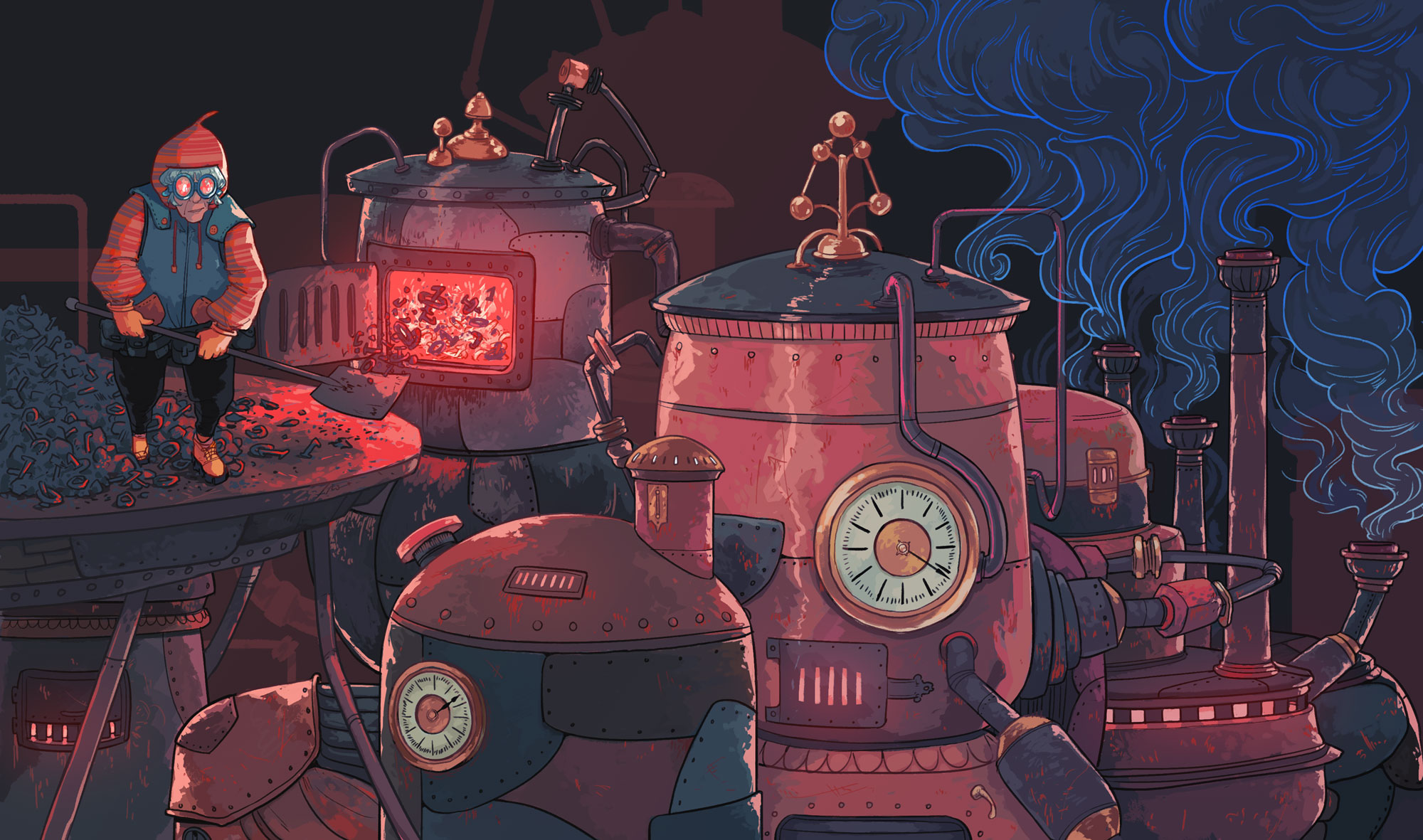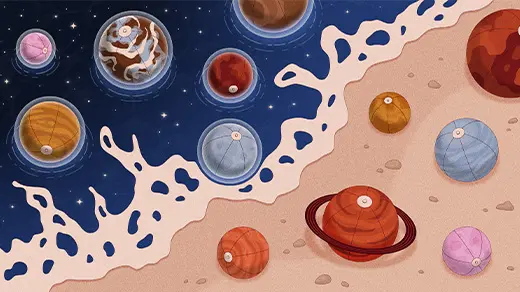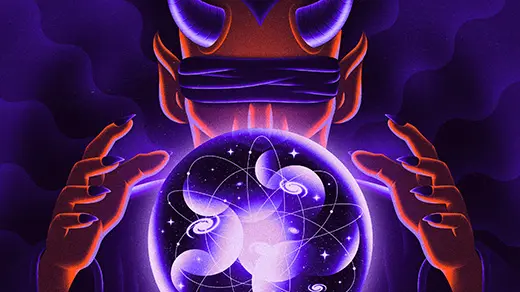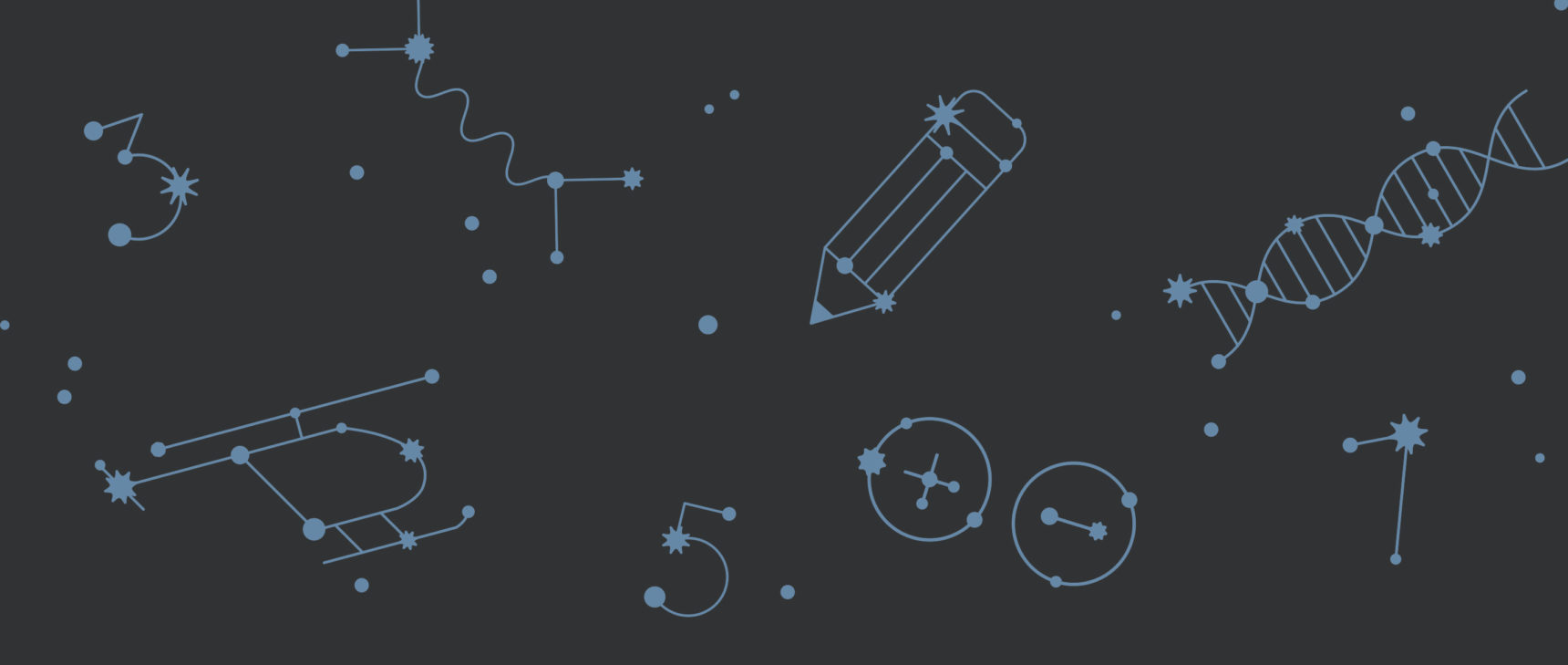The Quantum Thermodynamics Revolution

Ricardo Bessa for Quanta Magazine
Introduction
In his 1824 book, Reflections on the Motive Power of Fire, the 28-year-old French engineer Sadi Carnot worked out a formula for how efficiently steam engines can convert heat — now known to be a random, diffuse kind of energy — into work, an orderly kind of energy that might push a piston or turn a wheel. To Carnot’s surprise, he discovered that a perfect engine’s efficiency depends only on the difference in temperature between the engine’s heat source (typically a fire) and its heat sink (typically the outside air). Work is a byproduct, Carnot realized, of heat naturally passing to a colder body from a warmer one.
Carnot died of cholera eight years later, before he could see his efficiency formula develop over the 19th century into the theory of thermodynamics: a set of universal laws dictating the interplay among temperature, heat, work, energy and entropy — a measure of energy’s incessant spreading from more- to less-energetic bodies. The laws of thermodynamics apply not only to steam engines but also to everything else: the sun, black holes, living beings and the entire universe. The theory is so simple and general that Albert Einstein deemed it likely to “never be overthrown.”
Yet since the beginning, thermodynamics has held a singularly strange status among the theories of nature.
“If physical theories were people, thermodynamics would be the village witch,” the physicist Lídia del Rio and co-authors wrote last year in Journal of Physics A. “The other theories find her somewhat odd, somehow different in nature from the rest, yet everyone comes to her for advice, and no one dares to contradict her.”
Unlike, say, the Standard Model of particle physics, which tries to get at what exists, the laws of thermodynamics only say what can and can’t be done. But one of the strangest things about the theory is that these rules seem subjective. A gas made of particles that in aggregate all appear to be the same temperature — and therefore unable to do work — might, upon closer inspection, have microscopic temperature differences that could be exploited after all. As the 19th-century physicist James Clerk Maxwell put it, “The idea of dissipation of energy depends on the extent of our knowledge.”

In recent years, a revolutionary understanding of thermodynamics has emerged that explains this subjectivity using quantum information theory — “a toddler among physical theories,” as del Rio and co-authors put it, that describes the spread of information through quantum systems. Just as thermodynamics initially grew out of trying to improve steam engines, today’s thermodynamicists are mulling over the workings of quantum machines. Shrinking technology — a single-ion engine and three-atom fridge were both experimentally realized for the first time within the past year — is forcing them to extend thermodynamics to the quantum realm, where notions like temperature and work lose their usual meanings, and the classical laws don’t necessarily apply.
They’ve found new, quantum versions of the laws that scale up to the originals. Rewriting the theory from the bottom up has led experts to recast its basic concepts in terms of its subjective nature, and to unravel the deep and often surprising relationship between energy and information — the abstract 1s and 0s by which physical states are distinguished and knowledge is measured. “Quantum thermodynamics” is a field in the making, marked by a typical mix of exuberance and confusion.
“We are entering a brave new world of thermodynamics,” said Sandu Popescu, a physicist at the University of Bristol who is one of the leaders of the research effort. “Although it was very good as it started,” he said, referring to classical thermodynamics, “by now we are looking at it in a completely new way.”
Entropy as Uncertainty
In an 1867 letter to his fellow Scotsman Peter Tait, Maxwell described his now-famous paradox hinting at the connection between thermodynamics and information. The paradox concerned the second law of thermodynamics — the rule that entropy always increases — which Sir Arthur Eddington would later say “holds the supreme position among the laws of nature.” According to the second law, energy becomes ever more disordered and less useful as it spreads to colder bodies from hotter ones and differences in temperature diminish. (Recall Carnot’s discovery that you need a hot body and a cold body to do work.) Fires die out, cups of coffee cool and the universe rushes toward a state of uniform temperature known as “heat death,” after which no more work can be done.
The great Austrian physicist Ludwig Boltzmann showed that energy disperses, and entropy increases, as a simple matter of statistics: There are many more ways for energy to be spread among the particles in a system than concentrated in a few, so as particles move around and interact, they naturally tend toward states in which their energy is increasingly shared.
But Maxwell’s letter described a thought experiment in which an enlightened being — later called Maxwell’s demon — uses its knowledge to lower entropy and violate the second law. The demon knows the positions and velocities of every molecule in a container of gas. By partitioning the container and opening and closing a small door between the two chambers, the demon lets only fast-moving molecules enter one side, while allowing only slow molecules to go the other way. The demon’s actions divide the gas into hot and cold, concentrating its energy and lowering its overall entropy. The once useless gas can now be put to work.
Maxwell and others wondered how a law of nature could depend on one’s knowledge — or ignorance — of the positions and velocities of molecules. If the second law of thermodynamics depends subjectively on one’s information, in what sense is it true?

A century later, the American physicist Charles Bennett, building on work by Leo Szilard and Rolf Landauer, resolved the paradox by formally linking thermodynamics to the young science of information. Bennett argued that the demon’s knowledge is stored in its memory, and memory has to be cleaned, which takes work. (In 1961, Landauer calculated that at room temperature, it takes at least 2.9 zeptojoules of energy for a computer to erase one bit of stored information.) In other words, as the demon organizes the gas into hot and cold and lowers the gas’s entropy, its brain burns energy and generates more than enough entropy to compensate. The overall entropy of the gas-demon system increases, satisfying the second law of thermodynamics.
The findings revealed that, as Landauer put it, “Information is physical.” The more information you have, the more work you can extract. Maxwell’s demon can wring work out of a single-temperature gas because it has far more information than the average user.
But it took another half century and the rise of quantum information theory, a field born in pursuit of the quantum computer, for physicists to fully explore the startling implications.
Over the past decade, Popescu and his Bristol colleagues, along with other groups, have argued that energy spreads to cold objects from hot ones because of the way information spreads between particles. According to quantum theory, the physical properties of particles are probabilistic; instead of being representable as 1 or 0, they can have some probability of being 1 and some probability of being 0 at the same time. When particles interact, they can also become entangled, joining together the probability distributions that describe both of their states. A central pillar of quantum theory is that the information — the probabilistic 1s and 0s representing particles’ states — is never lost. (The present state of the universe preserves all information about the past.)
Understanding entropy as a subjective measure allows the universe as a whole to evolve without ever losing information. Even as parts of the universe, such as coffee, engines and people, experience rising entropy as their quantum information dilutes, the global entropy of the universe stays forever zero.
Renato Renner, a professor at ETH Zurich in Switzerland, described this as a radical shift in perspective. Fifteen years ago, “we thought of entropy as a property of a thermodynamic system,” he said. “Now in information theory, we wouldn’t say entropy is a property of a system, but a property of an observer who describes a system.”
Moreover, the idea that energy has two forms, useless heat and useful work, “made sense for steam engines,” Renner said. “In the new way, there is a whole spectrum in between — energy about which we have partial information.”
Entropy and thermodynamics are “much less of a mystery in this new view,” he said. “That’s why people like the new view better than the old one.”
Thermodynamics From Symmetry
The relationship among information, energy and other “conserved quantities,” which can change hands but never be destroyed, took a new turn in two papers published simultaneously last July in Nature Communications, one by the Bristol team and another by a team that included Jonathan Oppenheim at University College London. Both groups conceived of a hypothetical quantum system that uses information as a sort of currency for trading between the other, more material resources.
Imagine a vast container, or reservoir, of particles that possess both energy and angular momentum (they’re both moving around and spinning). This reservoir is connected to both a weight, which takes energy to lift, and a turning turntable, which takes angular momentum to speed up or slow down. Normally, a single reservoir can’t do any work — this goes back to Carnot’s discovery about the need for hot and cold reservoirs. But the researchers found that a reservoir containing multiple conserved quantities follows different rules. “If you have two different physical quantities that are conserved, like energy and angular momentum,” Popescu said, “as long as you have a bath that contains both of them, then you can trade one for another.”
In the hypothetical weight-reservoir-turntable system, the weight can be lifted as the turntable slows down, or, conversely, lowering the weight causes the turntable to spin faster. The researchers found that the quantum information describing the particles’ energy and spin states can act as a kind of currency that enables trading between the reservoir’s energy and angular momentum supplies. The notion that conserved quantities can be traded for one another in quantum systems is brand new. It may suggest the need for a more complete thermodynamic theory that would describe not only the flow of energy, but also the interplay between all the conserved quantities in the universe.
The fact that energy has dominated the thermodynamics story up to now might be circumstantial rather than profound, Oppenheim said. Carnot and his successors might have developed a thermodynamic theory governing the flow of, say, angular momentum to go with their engine theory, if only there had been a need. “We have energy sources all around us that we want to extract and use,” Oppenheim said. “It happens to be the case that we don’t have big angular momentum heat baths around us. We don’t come across huge gyroscopes.”

Popescu, who won a Dirac Medal last year for his insights in quantum information theory and quantum foundations, said he and his collaborators work by “pushing quantum mechanics into a corner,” gathering at a blackboard and reasoning their way to a new insight after which it’s easy to derive the associated equations. Some realizations are in the process of crystalizing. In one of several phone conversations in March, Popescu discussed a new thought experiment that illustrates a distinction between information and other conserved quantities — and indicates how symmetries in nature might set them apart.
“Suppose that you and I are living on different planets in remote galaxies,” he said, and suppose that he, Popescu, wants to communicate where you should look to find his planet. The only problem is, this is physically impossible: “I can send you the story of Hamlet. But I cannot indicate for you a direction.”
There’s no way to express in a string of pure, directionless 1s and 0s which way to look to find each other’s galaxies because “nature doesn’t provide us with [a reference frame] that is universal,” Popescu said. If it did — if, for instance, tiny arrows were sewn everywhere in the fabric of the universe, indicating its direction of motion — this would violate “rotational invariance,” a symmetry of the universe. Turntables would start turning faster when aligned with the universe’s motion, and angular momentum would not appear to be conserved. The early-20th-century mathematician Emmy Noether showed that every symmetry comes with a conservation law: The rotational symmetry of the universe reflects the preservation of a quantity we call angular momentum. Popescu’s thought experiment suggests that the impossibility of expressing spatial direction with information “may be related to the conservation law,” he said.
The seeming inability to express everything about the universe in terms of information could be relevant to the search for a more fundamental description of nature. In recent years, many theorists have come to believe that space-time, the bendy fabric of the universe, and the matter and energy within it might be a hologram that arises from a network of entangled quantum information. “One has to be careful,” Oppenheim said, “because information does behave differently than other physical properties, like space-time.”
Knowing the logical links between the concepts could also help physicists reason their way inside black holes, mysterious space-time swallowing objects that are known to have temperatures and entropies, and which somehow radiate information. “One of the most important aspects of the black hole is its thermodynamics,” Popescu said. “But the type of thermodynamics that they discuss in the black holes, because it’s such a complicated subject, is still more of a traditional type. We are developing a completely novel view on thermodynamics.” It’s “inevitable,” he said, “that these new tools that we are developing will then come back and be used in the black hole.”
What to Tell Technologists
Janet Anders, a quantum information scientist at the University of Exeter, takes a technology-driven approach to understanding quantum thermodynamics. “If we go further and further down [in scale], we’re going to hit a region that we don’t have a good theory for,” Anders said. “And the question is, what do we need to know about this region to tell technologists?”
In 2012, Anders conceived of and co-founded a European research network devoted to quantum thermodynamics that now has 300 members. With her colleagues in the network, she hopes to discover the rules governing the quantum transitions of quantum engines and fridges, which could someday drive or cool computers or be used in solar panels, bioengineering and other applications. Already, researchers are getting a better sense of what quantum engines might be capable of. In 2015, Raam Uzdin and colleagues at the Hebrew University of Jerusalem calculated that quantum engines can outpower classical engines. These probabilistic engines still follow Carnot’s efficiency formula in terms of how much work they can derive from energy passing between hot and cold bodies. But they’re sometimes able to extract the work much more quickly, giving them more power. An engine made of a single ion was experimentally demonstrated and reported in Science in April 2016, though it didn’t harness the power-enhancing quantum effect.
Popescu, Oppenheim, Renner and their cohorts are also pursuing more concrete discoveries. In March, Oppenheim and his postdoctoral researcher, Lluis Masanes, published a paper deriving the third law of thermodynamics — a historically confusing statement about the impossibility of reaching absolute-zero temperature — using quantum information theory. They showed that the “cooling speed limit” preventing you from reaching absolute zero arises from the limit on how fast information can be pumped out of the particles in a finite-size object. The speed limit might be relevant to the cooling abilities of quantum fridges, like the one reported in a preprint in February. In 2015, Oppenheim and other collaborators showed that the second law of thermodynamics is replaced, on quantum scales, by a panoply of second “laws” — constraints on how the probability distributions defining the physical states of particles evolve, including in quantum engines.
As the field of quantum thermodynamics grows quickly, spawning a range of approaches and findings, some traditional thermodynamicists see a mess. Peter Hänggi, a vocal critic at the University of Augsburg in Germany, thinks the importance of information is being oversold by ex-practitioners of quantum computing, who he says mistake the universe for a giant quantum information processor instead of a physical thing. He accuses quantum information theorists of confusing different kinds of entropy — the thermodynamic and information-theoretic kinds — and using the latter in domains where it doesn’t apply. Maxwell’s demon “gets on my nerves,” Hänggi said. When asked about Oppenheim and company’s second “laws” of thermodynamics, he said, “You see why my blood pressure rises.”

While Hänggi is seen as too old-fashioned in his critique (quantum-information theorists do study the connections between thermodynamic and information-theoretic entropy), other thermodynamicists said he makes some valid points. For instance, when quantum information theorists conjure up abstract quantum machines and see if they can get work out of them, they sometimes sidestep the question of how, exactly, you extract work from a quantum system, given that measuring it destroys its simultaneous quantum probabilities. Anders and her collaborators have recently begun addressing this issue with new ideas about quantum work extraction and storage. But the theoretical literature is all over the place.
“Many exciting things have been thrown on the table, a bit in disorder; we need to put them in order,” said Valerio Scarani, a quantum information theorist and thermodynamicist at the National University of Singapore who was part of the team that reported the quantum fridge. “We need a bit of synthesis. We need to understand your idea fits there; mine fits here. We have eight definitions of work; maybe we should try to figure out which one is correct in which situation, not just come up with a ninth definition of work.”
Oppenheim and Popescu fully agree with Hänggi that there’s a risk of downplaying the universe’s physicality. “I’m wary of information theorists who believe everything is information,” Oppenheim said. “When the steam engine was being developed and thermodynamics was in full swing, there were people positing that the universe was just a big steam engine.” In reality, he said, “it’s much messier than that.” What he likes about quantum thermodynamics is that “you have these two fundamental quantities — energy and quantum information — and these two things meet together. That to me is what makes it such a beautiful theory.”
Correction: This article was revised on May 5, 2017, to reflect that Lluis Masanes is a postdoctoral researcher, not a student.
This article was reprinted on Wired.com.



